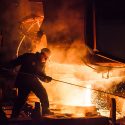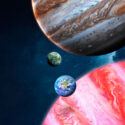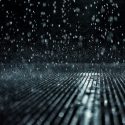Overnight, our planet has gone from a pale blue dot to a glistening white snowglobe. Stretches of Earth have become frozen wastelands that are completely inhospitable. And billions of people have been left unprepared for life below freezing.
What changes would our planet undergo? What could we do to combat this global freezing? Would humanity be stuck on a giant, irreversible snowball?
Earth has experienced several ice ages. During these periods, ice sheets pulse outward from the poles and then retract. But three of these freezes, between 580 and 750 million years ago, had such an extreme effect that the ice did not retract for millions of years. These are known as “snowball events.”
Temperatures reached -50 °C ( -58 °F). And the ice and snow reflected light into space. As more heat was reflected rather than absorbed by the planet, the temperature kept dropping. If you could have seen Earth from space back then, it would have looked like a glistening white ball.
Eventually, the Earth thawed. Otherwise, you wouldn’t be here watching this video. But if everything froze back again overnight, would you survive?
Let’s start by looking at what new kind of planet you’d be stepping onto. Ice sheets 1 km (0.6 mi) thick would cover Earth. Even in the tropics, ice would be as thick as 10 m (32.8 ft).
Most of the oceans would be covered in ice. Only near the equator, or areas with lots of geothermal heat, could liquid water still exist near the surface. Everything would be frigid. It would be so cold that most of life on Earth would not be able to survive.
Especially humans. People living in cold climates would have warm clothing. But this sudden freeze would be life or death for billions. Imagine living somewhere like Belize, Namibia or parts of Australia, where the temperature never drops below 15 °C (59 °F).
If you lived in those areas, you’d be at risk of death from exposure to the cold. The same would be true in many other parts of the world, especially for the poor and homeless or those with inadequate access to housing.
All power and energy systems would be disrupted. And with no electricity, billions of people would not have heating. Industries would grind to a halt. Even agriculture or livestock cultivation would be nearly impossible.
Humans would need to band together to conserve food, energy and other supplies. You would be ready for living on a giant snowball if you were a scientist based on an arctic research station.
At Amundsen-Scott Station in Antarctica, the average temperature is -82.8 °C (-117 °F). Scientists near the South Pole live in shelters built to withstand the cold and ice. Some even have gyms, greenhouses, a movie room and a sauna.
Life in a shelter would be very confined. You would only go outside for specific tasks. To venture outdoors, you would need layers. A lot of layers. Scientists at these stations wear nearly 9 kg (20 lb) of clothing. It takes them about 10 minutes to get dressed. Any exposed skin could be frost-bitten in less than five minutes.
This deep freeze would also make the Earth incredibly dry, as all precipitation would turn to ice or snow. That dry air could make you feel dizzy. You would need to constantly thaw water to drink.
The only way to get around would be with a snowmobile. Or, if you are looking for a little recreation, you could master kite-surfing on snow dunes. But be careful. In Earth’s lower latitudes, there would be howling winds. This would be another extreme element making life difficult.
Researchers still don’t know how the Earth thawed from these previous snowball events. Unfortunately, if we wanted to reverse the freeze, we might have to change our thinking about greenhouse gases and global warming.
We would need to pump the atmosphere with carbon dioxide and methane. That means releasing pure gas or burning even more fossil fuels. On the other hand, we could use bombs to detonate volcanoes around the world. Volcanic activity is likely what warmed the planet in previous freezes. But these solutions beg the question of what kind of ecological crisis we might create next?
Sources
- “What Was Frigid ‘Snowball Earth’ Really Like?”. Nola Taylor Redd. 2021. space.com.
- “Here’s What The People Currently At Vostok Station In Antarctica Are Up To”. Gene, Kosowan. 2020. Thetravel.
- “Snowball Earth: The times our planet was covered in ice”. 2021. astronomy.com.
- “Where is the coldest place on Earth?”. Sawal, Ibrahim. 2021. New Scientist.
- “Harvard Researchers Battle The Extreme At The South Pole”. 2019. Harvard Gazette.



























